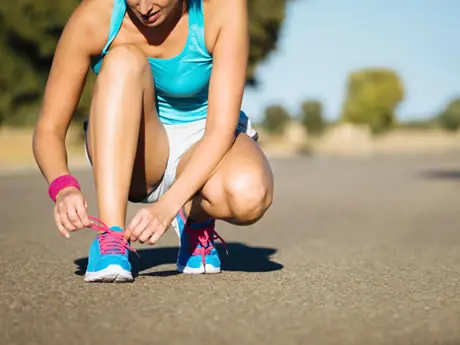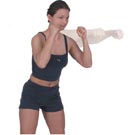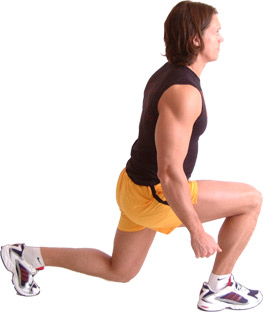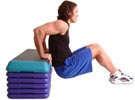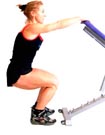To make the journey from Tabata newbie to pro a bit easier, we called in the big guns: renowned trainers and Greatist Experts Ilen Bell and Kelvin Gary. Bell and Gary each picked one or two of the best moves for each area of the body, with added weights and using bodyweight alone. Each of these four-minute wonders packs a serious punch (just ask my quads after a round of squats), so start with just one or two exercises per workout.
Feel free to rest for a few minutes in between the 4-minute bouts, or go back-to-back for an added challenge.
THE MOVES
Full Body
1. Burpee: Start standing, then crouch to a low squat position with the hands on the floor. Then, kick feet back to a plank, then down into the bottom of a push-up. Push off the ground and quickly return to the squat position. Last step? Jump up as high as possible before squatting down again and jumping back into the next push-up.

Lower Body
2. Jump squat: Stand with the feet hip-width apart, toes pointing forward. Sit back into a squat (hips below parallel, please!) then drive the whole body up through the heels, shifting weight onto the balls of the feet as you lift off. Be sure to land on the balls of the feet and immediately bend the knees into a full squat. Make sure the knees aren't wobbling side to side while squatting or landing from a jump.
3. Lunge jump: Start standing with the feet together and lunge the right foot forward, bending the knee about 90-degrees and keeping the torso vertical. Then, jump straight up, and while in the air, switch legs and land in a lunge with the left foot forward.
4. Dumbbell front squat: Hold a dumbbell at the sternum (the center of the chest) and do a basic front squat. Place feet a little wider than shoulder-width apart, hips stacked over knees, knees over ankles. Inhale and unlock the hips, bringing them back as the knees begin to bend. Keep the chest and shoulders upright, and continue until the hips are slightly less than 90 degrees from the ground. On the way back up, engage the core and drive through the heels to return to standing.
5. Kettlebell swing: Stand up straight, with feet a bit wider than hip-distance apart. Grab hold of the kettlebell with both hands, keeping the palms face down and arms in front of the body. Keep the knees slightly bent and drive the hips and bell back (it's not a squat, so the knees shouldn't have to bend that much), lowering the body just a bit to an athletic stance. In one fluid motion, explosively drive the hips forward while swinging the kettlebell, engaging the glutes and core.

Upper Body
6. Push-up: Get into a plank position with hands planted a little bit wider than shoulder width apart. Keep the elbows close to the body throughout the movement. Ground the toes into the floor and engage the abs and back so the body is neutral. Lower the body in one straight line until the chest touches the floor. Keeping the core engaged, exhale, and push back to the start position.
7. Overhead neutral grip press: Stand with the feet shoulder-width apart core tight. Raise the dumbbell, kettlebell, or barbell up to the shoulders with palms facing each other and the elbows below the wrists. Press the weights upward until the arms are fully extended overhead, and then lower back to the shoulders.
Cardio
8. Sprints: To get extra speedy, make sure form fits function. Hold the correct posture, with eyes up, chest tall, shoulders relaxed, and arms swinging up and down with the elbows at 45-degree angles.
9. Stationary bike or rower: Hopping on the bike for a quick spin is pretty self-explanatory, but the indoor rower is a bit trickier. First, strap feet into the foot stretchers, sit up tall, and grab the handle. Roll forward until legs are completely bent and arms are reaching forward.
From this starting position (called the "catch"), explosively drive the legs back. When the legs are nearly extended, swing the torso back and pull the arms in so the handle is almost touching the rib cage. From here (aka the "finish") recover by stretching the arms straight out, returning the upper body to a straight, vertical position, and bending the legs back to the catch.
Core
10. Russian twist: Sit on the floor with the knees bent and feet together and lifted a few inches off the floor. With the back at a 45-degree angle from the ground, move the arms from one side to another in a twisting motion. Go super slow, twisting the shoulders completely from side to side.

11. Ski abs: Start in pushup position with hands under the shoulders and core engaged. Jump the feet to the left side of the body, as close to the upper torso as possible. Jump the legs back to a straight plank position and repeat on the right side.
With the exception of the weighted movements, most of these can be performed anywhere, any time. All you need is a set of comfy clothes and a serious work ethic. To make keeping track of the time easier, consider downloading a Tabata timer app. Again, consider meeting with a trainer to go over correct form (even if you've previously done these moves) before starting a Tabata fitness regimen to prevent injury.

